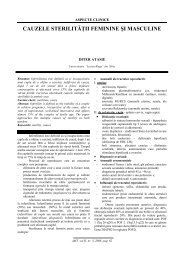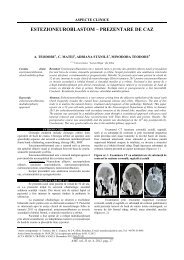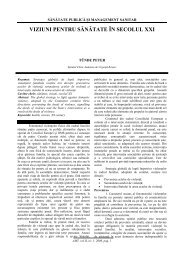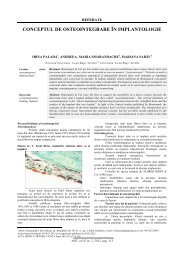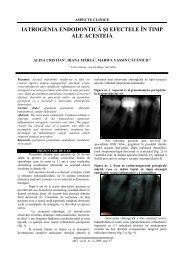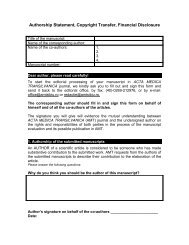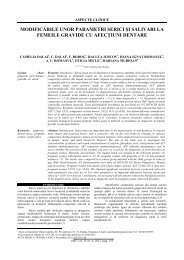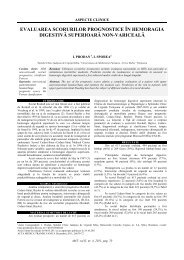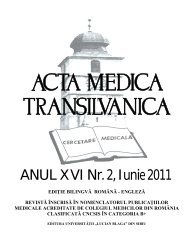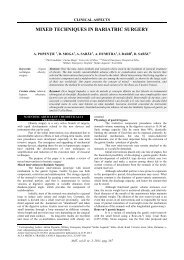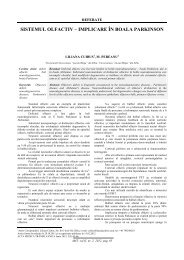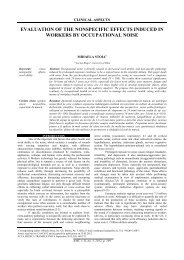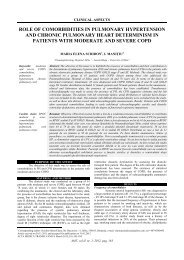visual field defects in optic chiasm lesions - Acta Medica Transilvanica
visual field defects in optic chiasm lesions - Acta Medica Transilvanica
visual field defects in optic chiasm lesions - Acta Medica Transilvanica
Create successful ePaper yourself
Turn your PDF publications into a flip-book with our unique Google optimized e-Paper software.
Lesions that damage the posterior aspect of the <strong>optic</strong><br />
<strong>chiasm</strong> produce characteristic <strong>defects</strong> <strong>in</strong> the <strong>visual</strong> <strong>field</strong>s:<br />
bitemporal hemianopic scotomas. Such <strong>defects</strong> may be<br />
cecocentral scotomas and attributed to a toxic, metabolic, or<br />
even hereditary process rather than to a tumour. True bitemporal<br />
hemianopic scotomas are almost always associated with normal<br />
<strong>visual</strong> acuity and colour perception, whereas cecocentral<br />
scotomas are <strong>in</strong>variably associated with reduced <strong>visual</strong> acuity<br />
and dyschromatopsia. Lesions that damage the posterior aspect<br />
of the <strong>optic</strong> <strong>chiasm</strong> may also damage one of the <strong>optic</strong> tracts, thus<br />
produc<strong>in</strong>g an homonymous <strong>field</strong> defect that is comb<strong>in</strong>ed with<br />
whatever <strong>field</strong> defect has occurred from damage to the <strong>optic</strong><br />
<strong>chiasm</strong>. Bitemporal homonymous scotomas are important <strong>in</strong><br />
localiz<strong>in</strong>g a lesion.<br />
Visual Field Defects Caused by Lesions That Damage the<br />
Optic Chiasm after Initially Damag<strong>in</strong>g the Optic Nerve or<br />
Optic Tract<br />
If there is extension of a lesion from the <strong>optic</strong> nerve or<br />
the <strong>optic</strong> tract to the <strong>optic</strong> <strong>chiasm</strong>, the bl<strong>in</strong>d eye usually is on the<br />
side of the lesion. When there is extension of a lesion from an<br />
<strong>optic</strong> nerve or <strong>optic</strong> tract to the <strong>optic</strong> <strong>chiasm</strong>, the bl<strong>in</strong>d (or nearbl<strong>in</strong>d)<br />
eye is always on the side of the orig<strong>in</strong>al lesion, and when<br />
there is extension of a lesion from the <strong>optic</strong> <strong>chiasm</strong> to the <strong>optic</strong><br />
nerve or to the <strong>optic</strong> tract, the bl<strong>in</strong>d (or near-bl<strong>in</strong>d) eye is always<br />
on the side of the extension of the lesion.<br />
The degree of <strong>visual</strong> <strong>field</strong> loss is usually asymmetrical.<br />
Optic atrophy is only present <strong>in</strong> 50% of cases with <strong>visual</strong> <strong>field</strong><br />
<strong>defects</strong>. For this reason, it is extremely important to perform<br />
careful exam<strong>in</strong>ation of the <strong>visual</strong> <strong>field</strong>s <strong>in</strong> all patients with<br />
unexpla<strong>in</strong>ed <strong>visual</strong> loss.<br />
Compression of the <strong>optic</strong> <strong>chiasm</strong> may be symmetrical<br />
or asymmetrical relat<strong>in</strong>g to the size of lesion and its degree of<br />
<strong>in</strong>volvement of the <strong>optic</strong> <strong>chiasm</strong>, <strong>optic</strong> nerve and <strong>optic</strong> tract.<br />
Symmetrical or asymmetrical compression is reflected by the<br />
presence of bilateral or unilateral <strong>visual</strong> <strong>field</strong> <strong>defects</strong>.<br />
At the junction of the <strong>optic</strong> nerve and <strong>optic</strong> <strong>chiasm</strong>, the<br />
crossed and uncrossed ret<strong>in</strong>al nerve fibres are separated;<br />
consequently, a small lesion of the <strong>optic</strong> nerve at this level<br />
affect<strong>in</strong>g either the crossed or the uncrossed fibres may give rise<br />
to a unilateral hemianopic defect. The <strong>in</strong>volvement of the<br />
ipsilateral <strong>optic</strong> nerve close enough to the <strong>optic</strong> <strong>chiasm</strong> (to<br />
impair selectively conduction <strong>in</strong> cross<strong>in</strong>g nasal ret<strong>in</strong>al fibres<br />
from the ipsilateral eye, but too anterior to affect the cross<strong>in</strong>g<br />
nasal ret<strong>in</strong>al fibres from the contralateral eye) produces<br />
monocular temporal hemi<strong>field</strong> loss. Junctional scotoma:<br />
temporal hemianopsic central scotoma associated with<br />
deficiency <strong>in</strong> opposite superior temporal quadrant, situation<br />
described by Traquir. Junctional scotoma presents a lesion<br />
placed <strong>in</strong> <strong>in</strong>side angle, anterior of <strong>chiasm</strong>. The junction scotoma<br />
is met particularly <strong>in</strong> tumours of the anterior angle of <strong>chiasm</strong> at<br />
the junction between the <strong>optic</strong> nerve and the <strong>chiasm</strong>. The<br />
suffer<strong>in</strong>g of these fibres at the junction between the <strong>optic</strong> nerve<br />
and <strong>chiasm</strong>, that is the suffer<strong>in</strong>g of the „anterior knee”, produces<br />
a superior temporal peripherial deficiency, to the opposite eye.<br />
The fibres from the nasal <strong>in</strong>ferior quadrant of the ret<strong>in</strong>a go<br />
through the anterior part of the <strong>chiasm</strong>, those com<strong>in</strong>g from the<br />
superior nasal quadrants go through the posterior side of the<br />
<strong>chiasm</strong>. That is why pituitar tumours produce <strong>in</strong>itially<br />
deficiencies <strong>in</strong> the superior temporal quadrant, and the<br />
craniopharyngiomas produce <strong>in</strong>itially deficiencies <strong>in</strong> the <strong>in</strong>ferior<br />
temporal <strong>field</strong>.<br />
Arcuate <strong>visual</strong> <strong>field</strong> <strong>defects</strong> have been proposed to<br />
result from vascular changes <strong>in</strong> the <strong>optic</strong> nerve rather than at the<br />
<strong>optic</strong> <strong>chiasm</strong>. Compression of the <strong>optic</strong> nerve at the anterior<br />
<strong>optic</strong> <strong>chiasm</strong> level might also expla<strong>in</strong> the presence of an arcuate<br />
defect. Trobe (1974) described hemianopic temporal arcuate<br />
CLINICAL ASPECTS<br />
AMT, v. II, no. 2, 2012, p. 186<br />
<strong>visual</strong> <strong>field</strong> <strong>defects</strong> due to a lesion <strong>in</strong> the anterocentral <strong>optic</strong><br />
<strong>chiasm</strong>, where cross<strong>in</strong>g and non-cross<strong>in</strong>g portions of the nerve<br />
fibre bundles separate; the lesion would selectively impair<br />
cross<strong>in</strong>g fibres.<br />
Bitemporal hemianopic central scotomas<br />
(heteronimous) are caused by a lesion strictly placed at <strong>chiasm</strong>,<br />
particularly on its posterior edge. The unilateral central scotoma<br />
sometimes expresses a compression lesion: tumour of sellar<br />
area, men<strong>in</strong>gioma of olfactory ditch. The bilateral central<br />
scotoma is mentioned among different types of <strong>visual</strong> troubles<br />
dur<strong>in</strong>g the opto<strong>chiasm</strong>a arachnoid. Hemianopia is a bilateral<br />
deficiency of <strong>visual</strong> <strong>field</strong>, represent<strong>in</strong>g an alteration of the<br />
pathways from the <strong>optic</strong> <strong>chiasm</strong> up to occipital cortex. With<br />
reference to the place of lesion, hemianopic deficiencies present<br />
different aspects which have a very important significance if<br />
neuropathological diagnosis. Bitemporal hemianopia is met <strong>in</strong><br />
sagittal lesion of <strong>chiasm</strong>, <strong>in</strong> pituitary adenoma,<br />
craniopharyngiomas, gliomas of <strong>optic</strong> <strong>chiasm</strong>, opto<strong>chiasm</strong>al<br />
arahnoid, tubersellar men<strong>in</strong>giomas, obstructive hydrocephalus<br />
with <strong>chiasm</strong>atic compression by the bottom of the third<br />
ventricle, carotid aneurysms situated <strong>in</strong> sellar, anterior cerebral<br />
aneurysms, craniocerebral trauma with <strong>chiasm</strong> <strong>in</strong>volvement.<br />
When we come across a temporal hemianopic<br />
deficiency to an eye and bl<strong>in</strong>dness to the other, it is difficult to<br />
state the <strong>chiasm</strong>atical orig<strong>in</strong> of the lesion. It is possible that, by<br />
means of a big <strong>in</strong>dex or by us<strong>in</strong>g a candle <strong>in</strong> an obscure room,<br />
we can observe the presence of temporal ret<strong>in</strong>al sensitivity of<br />
the atrophy of the eye and the absence of it <strong>in</strong> the nasal ret<strong>in</strong>al<br />
area. B<strong>in</strong>asal heteronymous hemianopia is the loss of both nasal<br />
half <strong>field</strong>s, correspond<strong>in</strong>g to the lesion of the fibres of temporal<br />
half ret<strong>in</strong>as. The lesion focuses on the temporal uncrossed direct<br />
bundle at the <strong>chiasm</strong> level (<strong>in</strong> lateral lesion of the <strong>chiasm</strong>).<br />
CRANIOPHARYNGIOMA<br />
Sometimes hemianopia appears as a result of the<br />
compression of the <strong>optic</strong> pathway by tumour of sellar area<br />
(craniopharyngiom).Visual <strong>field</strong> <strong>defects</strong> with<br />
craniopharyngiomas are frequently asymmetric bitemporal<br />
hemianopias or a homonymous pattern with reduced acuity. The<br />
craniopharyngiomas will not only cause <strong>in</strong>ferotemporal <strong>field</strong><br />
<strong>defects</strong> but also bitemporal hemianopic scotomas. Situations<br />
start<strong>in</strong>g with homonim hemianopic central scotomas and<br />
paradoxal situations of homonim hemianopic with spar<strong>in</strong>g of the<br />
macula are quoted.<br />
Figure no. 1. Humphrey perimeter <strong>visual</strong> <strong>field</strong> assessment:<br />
craniopharyngioma. Bitemporal hemianopia is present with<br />
some superior nasal <strong>visual</strong> <strong>field</strong> impairment also present<br />
bilaterally.



